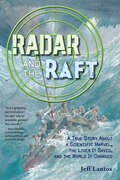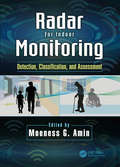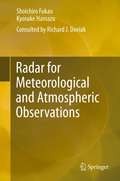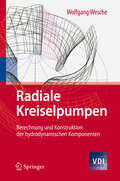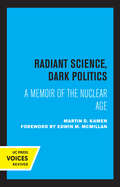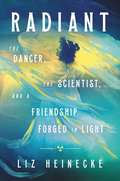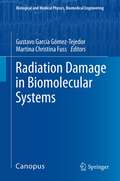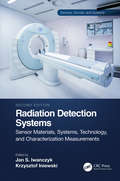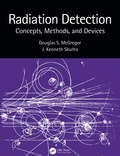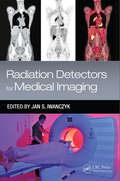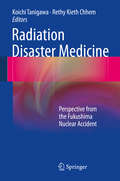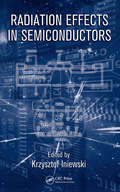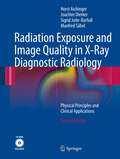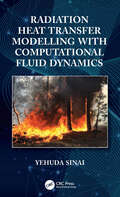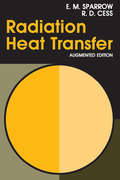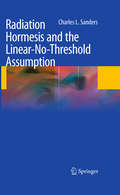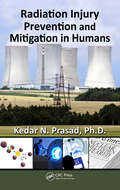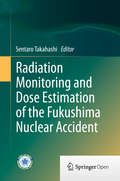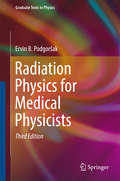- Table View
- List View
Radar and the Raft: A True Story About a Scientific Marvel, the Lives it Saved, and the World it Changed
by Jeff LantosThis science-history nonfiction adventure mash-up will be on every middle grade reader's radar.Who knew that an improbable rescue during WWII would be facilitated by scientific discoveries in the 18th century?Expert researcher and educator Jeff Lantos makes the history-science connection between batteries and radar and one oceanic adventure in this engaging middle-grade escapade told in two intertwining storylines.Readers are first invited to follow scientific discoveries in the 1700s that eventually lead to the creation of radar, and are then immersed in a world where World War II rages. German U-boats sink ships, and the ship just hit has an American mom and her two young kids aboard. Now Ethel, Robert, and Mary Bell are on a raft with fourteen other people, floating in the ocean and hoping for rescue.Lantos expertly weaves radar's story of discovery with the Bell family's harrowing journey, bringing readers on an exciting fast-paced adventure through history.♦ "A rare and exhilarating mix of hard science and seagoing terror."—Kirkus Reviews, starred review
Radar for Indoor Monitoring: Detection, Classification, and Assessment
by Moeness AminThis book aims to capture recent advances and breakthroughs in in-home radar monitoring of human motions and activities. It addresses three key attributes of radar for in-door human monitoring, namely: motion classification including fall, detection of vital signs, and categorization of human gait for risk assessment and progression of physical impairments and disabilities. It explores recent developments in radar technology for human monitoring inside homes and residences. The reader will learn enhanced detection and classification techniques of radar signals associated with human micro- and macro-motions. Furthermore, the book includes examples using real data collected from healthy individuals, patients, and retirement communities based on the subject Doppler and range information, and using different single and multi-antenna radar system configurations. Results are also presented using modeled data based on biomechanics and kinematics. Indoor monitoring is further demonstrated using alternative technologies of infrared sensors and RF signals of opportunities.
Radar for Meteorological and Atmospheric Observations
by Kyosuke Hamazu Shoichiro FukaoEpoch-making progress in meteorology and atmospheric science has always been hastened by the development of advanced observational technologies, in particular, radar technology. This technology depends on a wide range of sciences involving diverse disciplines, from electrical engineering and electronics to computer sciences and atmospheric physics. Meteorological radar and atmospheric radar each has a different history and has been developed independently. Particular radar activities have been conducted within their own communities. Although the technology of these radars draws upon many common fields, until now the interrelatedness and interdisciplinary nature of the research fields have not been consistently discussed in one volume containing fundamental theories, observational methods, and results. This book is by two authors who, with long careers in the two fields, one in academia and the other in industry, are ideal partners for writing on the comprehensive science and technology of radars for meteorological and atmospheric observations.
Radial Basis Function (RBF) Neural Network Control for Mechanical Systems
by Jinkun LiuRadial Basis Function (RBF) Neural Network Control for Mechanical Systems is motivated by the need for systematic design approaches to stable adaptive control system design using neural network approximation-based techniques. The main objectives of the book are to introduce the concrete design methods and MATLAB simulation of stable adaptive RBF neural control strategies. In this book, a broad range of implementable neural network control design methods for mechanical systems are presented, such as robot manipulators, inverted pendulums, single link flexible joint robots, motors, etc. Advanced neural network controller design methods and their stability analysis are explored. The book provides readers with the fundamentals of neural network control system design. This book is intended for the researchers in the fields of neural adaptive control, mechanical systems, Matlab simulation, engineering design, robotics and automation. Jinkun Liu is a professor at Beijing University of Aeronautics and Astronautics.
Radial-velocity Searches for Planets Around Active Stars
by Raphaëlle D. HaywoodThis thesis develops new and powerful methods for identifying planetary signals in the presence of "noise" generated by stellar activity, and explores the physical origin of stellar intrinsic variability, using unique observations of the Sun seen as a star. In particular, it establishes that the intrinsic stellar radial-velocity variations mainly arise from suppression of photospheric convection by magnetic fields. With the advent of powerful telescopes and instruments we are now on the verge of discovering real Earth twins in orbit around other stars. The intrinsic variability of the host stars themselves, however, currently remains the main obstacle to determining the masses of such small planets. The methods developed here combine Gaussian-process regression for modeling the correlated signals arising from evolving active regions on a rotating star, and Bayesian model selection methods for distinguishing genuine planetary signals from false positives produced by stellar magnetic activity. The findings of this thesis represent a significant step towards determining the masses of potentially habitable planets orbiting Sun-like stars.
Radiale Kreiselpumpen
by Wolfgang WescheDie Berechnung und Konstruktion der hydrodynamischen Komponenten von radialen Kreiselpumpen steht im Mittelpunkt dieses Buchs. Dabei konzentriert sich der Autor auf die Kernthemen der Pumpenhydrodynamik, geht aber auch auf das Regelverhalten verschiedener Pumpentypen ein. Er behandelt das Betriebsverhalten von Pumpen im Turbinenbetrieb und deren Unterschiede zu "echten" Turbinen. Beispiele erleichtern den Einstieg in die Entwurfsarbeit. Das praxisorientierte Buch eignet sich sowohl für die Praxis in der Industrie als auch für das Studium.
Radiant Science, Dark Politics: A Memoir of the Nuclear Age
by Martin D. KamenThis title is part of UC Press's Voices Revived program, which commemorates University of California Press’s mission to seek out and cultivate the brightest minds and give them voice, reach, and impact. Drawing on a backlist dating to 1893, Voices Revived makes high-quality, peer-reviewed scholarship accessible once again using print-on-demand technology. This title was originally published in 1985.
Radiant: The Dancer, The Scientist, and a Friendship Forged in Light
by Liz HeineckePart hidden history, part love letter to creative innovation, this is the true story of an unlikely friendship between a dancer, Loie Fuller, and a scientist, Marie Curie, brought together by an illuminating discovery. At the turn of the century, Paris was a hotbed of creativity. Technology boomed, delivering to the world electric light, the automobile, and new ways to treat disease, while imagination blossomed, creating Art Nouveau, motion pictures, and modernist literature. A pivotal figure during this time, yet largely forgotten today, Loie Fuller was an American performance artist who became a living symbol of the Art Nouveau movement with her hypnotic dances and stunning theatrical effects. Credited today as the pioneer of modern dance, she was perennially broke, never took no for an answer, spent most of her life with a female partner, and never questioned her drive. She was a visionary, a renegade, and a loyal friend. In the early 1900s, she heard about Marie Curie's discovery of a glowing blue element and dreamed of using it to dazzle audiences on stage. While Loie's dream wouldn't be realized, her connection with Marie and their shared fascination with radium endured. Radiant is the true story of Marie Curie and Loie Fuller, two revolutionary women drawn together at the dawn of a new era by a singular discovery, and the lifelong friendship that grew out of their shared passion for enlightenment.
Radiation Chemistry of Polymers
by V.S. IvanovPart of the series "New Concepts in Polymer Science", this volume contains information on the main theoretical and practical problems involved in radiation chemistry of polymers. The processes of polymerization and modification of polymers by grafting, crosslinking and degradation, induced by ionizing radiation, are all described, as well as the radiation resistance of polymers and their protection from radiation. The book also contains applications of radiation chemistry of polymers, such as: principles of selection of radiation-chemical processes for industrial use; choice of radiation sources for specific processes; modification of textile and film materials by grafting; manufacturing of heat-shrinkable, thermostable and mechanically strong polymer products; composites; rubber vulcanizates and self-adhesive products; paints and coatings; man-made fibres; materials for microelectronics; and polymer materials for medical purposes.
Radiation Damage in Biomolecular Systems
by Martina Christina Fuss Gustavo García Gómez-TejedorSince the discovery of X-rays and radioactivity, ionizing radiations have been widely applied in medicine both for diagnostic and therapeutic purposes. The risks associated with radiation exposure and handling led to the parallel development of the field of radiation protection. Pioneering experiments done by Sanche and co-workers in 2000 showed that low-energy secondary electrons, which are abundantly generated along radiation tracks, are primarily responsible for radiation damage through successive interactions with the molecular constituents of the medium. Apart from ionizing processes, which are usually related to radiation damage, below the ionization level low-energy electrons can induce molecular fragmentation via dissociative processes such as internal excitation and electron attachment. This prompted collaborative projects between different research groups from European countries together with other specialists from Canada, the USA and Australia. This book summarizes the advances achieved by these research groups after more than ten years of studies on radiation damage in biomolecular systems. An extensive Part I deals with recent experimental and theoretical findings on radiation induced damage at the molecular level. It includes many contributions on electron and positron collisions with biologically relevant molecules. X-ray and ion interactions are also covered. Part II addresses different approaches to radiation damage modelling. In Part III biomedical aspects of radiation effects are treated on different scales. After the physics-oriented focus of the previous parts, there is a gradual transition to biology and medicine with the increasing size of the object studied. Finally, Part IV is dedicated to current trends and novel techniques in radiation reserach and the applications hence arising. It includes new developments in radiotherapy and related cancer therapies, as well as technical optimizations of accelerators and totally new equipment designs, giving a glimpse of the near future of radiation-based medical treatments.
Radiation Detection Systems: Medical Imaging, Industrial Testing, and Security Applications (Devices, Circuits, and Systems)
by Jan S. IwanczykThe advances in semiconductor detectors, scintillators, photodetectors such as silicon photomultipliers (SiPM), and readout electronics have experienced tremendous growth in recent years in terms of basic technologies and a variety of applications. The second edition of Radiation Detection Systems presents variety of radiation detection systems, giving readers a broad view of the state-of-the-art in the design of detectors, front-end electronics, and systems offering optimized choices of the detection tools for a particular application. The new edition has been divided into two volumes. This volume on Medical Imaging, Industrial Testing, and Security Applications presents specific applications of the detection systems in medical imaging, industrial testing, and security applications. These newely developed technologies play a vital role in the detection, diagnosis, and treatment of major human diseases. Featuring contributions from leading experts and pioneers in their respective fields, this book: Describes new advances in development of detection systems based on CdZnTe (CZT) and CdTe detectors utilizing a direct conversion of radiation to electric signals Reports a recent progress in technologies and performance of SiPM used for reading the light from scintillators Explores exciting new application opportunities created by development of the cutting-edge detection technologies in X-ray spectroscopy, computed tomography (CT), bone dosimetry, and nuclear medicine (PET, SPECT) Considers the future use of photon-counting detectors in clinical CT scanners providing K-edge imaging to reduce the amount of contrast agents and ultimately offering both an anatomical and a functional information Describes, uses of radiation detection systems in security applications such as luggage scanning, dirty bomb detection, and border control With its combined coverage of new materials and innovative new system approaches, as well as a succinct overview of recent developments, this book is an invaluable tool for any engineer, professional, or student working in electronics or an associated field. Readers can refer to the other volume, Sensor Materials, Systems, Technology, and Characterization Measurements, which puts emphasis on sensor materials, detector structures, front electronics technology, and their designs and system optimization for different applications.
Radiation Detection Systems: Sensor Materials, Systems, Technology, and Characterization Measurements (Devices, Circuits, and Systems)
by Jan S. IwanczykThe advances in semiconductor detectors, scintillators, photodetectors such as silicon photomultipliers (SiPM), and reaodut electronics have experienced tremendous growth in recent years in terms of basic technologies and variety of applications.The second edition of the book Radiation Detection Systems presents variety of radiation detection systems giving readers a broad view of the state-of–the-art in the design of detectors, front-end electronics and systems offering optimized choices of the detection tools for a particular application. The new edition has been divided into two volumes. This first volume, on Sensor Materials, Systems, Technology and Characterization Measurements puts emphasis on sensor materials, detector structures, front electronics technology and their designs as well as system optimization for different applications. Also, the book include characterization measurements of the developed detection systems. Featuring contributions from leading experts and pioneers in their respective fields, this book • describes progress in growth technologies of cadmium zinc telluride (CdZnTe) and cadmium telluride (CdTe) materials• shows variety of specific detector structure designs and their integration with front-end amplification/processing electronics• presents detection systems based on CdZnTe and CdTe detector technologies that are optimized for specific applications. The designed systems are characterized in terms of their spectral responses, spatial and timing resolutions• addresses incomplete charge collection, pulse pileup, charge sharing between neighboring detector pixels and other phenomena that can degrade the spectral response of photon-counting detectors• reports new developments of silicon photomultipliers used for reading the light from scintillators that starting to make a big impact particularly in the design concepts of novel medical instrumentation With its combined coverage of new materials and innovative new system approaches, as well as a succinct overview of recent developments, this book is an invaluable tool for any engineer, professional, or student working in electronics or an associated field. Readers can refer to the second book to get a detailed understanding of more specific applications of the detection systems in medical imaging, industrial testing and security applications.
Radiation Detection: Concepts, Methods, and Devices
by J. Kenneth Shultis Douglas McGregorRadiation Detection: Concepts, Methods, and Devices provides a modern overview of radiation detection devices and radiation measurement methods. The book topics have been selected on the basis of the authors’ many years of experience designing radiation detectors and teaching radiation detection and measurement in a classroom environment. This book is designed to give the reader more than a glimpse at radiation detection devices and a few packaged equations. Rather it seeks to provide an understanding that allows the reader to choose the appropriate detection technology for a particular application, to design detectors, and to competently perform radiation measurements. The authors describe assumptions used to derive frequently encountered equations used in radiation detection and measurement, thereby providing insight when and when not to apply the many approaches used in different aspects of radiation detection. Detailed in many of the chapters are specific aspects of radiation detectors, including comprehensive reviews of the historical development and current state of each topic. Such a review necessarily entails citations to many of the important discoveries, providing a resource to find quickly additional and more detailed information. This book generally has five main themes: Physics and Electrostatics needed to Design Radiation Detectors Properties and Design of Common Radiation Detectors Description and Modeling of the Different Types of Radiation Detectors Radiation Measurements and Subsequent Analysis Introductory Electronics Used for Radiation Detectors Topics covered include atomic and nuclear physics, radiation interactions, sources of radiation, and background radiation. Detector operation is addressed with chapters on radiation counting statistics, radiation source and detector effects, electrostatics for signal generation, solid-state and semiconductor physics, background radiations, and radiation counting and spectroscopy. Detectors for gamma-rays, charged-particles, and neutrons are detailed in chapters on gas-filled, scintillator, semiconductor, thermoluminescence and optically stimulated luminescence, photographic film, and a variety of other detection devices.
Radiation Detectors for Medical Imaging (Devices, Circuits, and Systems)
by Jan S. IwanczykRadiation Detectors for Medical Imaging discusses the current state of the art and future prospects of photon-counting detectors for medical imaging applications. Featuring contributions from leading experts and pioneers in their respective fields, this book:Describes x-ray spectral imaging detectors based on cadmium zinc telluride (CdZnTe) and cad
Radiation Disaster Medicine
by Rethy Kieth Chhem Koichi TanigawaWhile many books are available on disaster medicine, none is specifically devoted to the role of physicians in the management of patients exposed to radiation leakage from a damaged nuclear power plant. Radiation Disaster Medicine aims to fill this void based on the response to the Fukushima nuclear accident. Each chapter addresses principles and practices of radiation medicine within the specific context of that accident. Topics covered include the role of physicians in radiation disasters, the concepts of external and internal exposure, prehospital and hospital response, disaster behavioral health, and radiation emergency response from the perspective of national and international institutions. Most of the contributors are active educators and researchers in radiation medicine with first-hand experience in dealing with prehospital triage and management of patients within secondary and tertiary care hospitals in Japan.
Radiation Effects in Polymeric Materials (Springer Series on Polymer and Composite Materials)
by Vijay Kumar Vishal Sharma Babulal Chaudhary Kartikey VermaThis book provides an introduction of how radiation is processed in polymeric materials, how materials properties are affected and how the resulting materials are analyzed. It covers synthesis, characterization, or modification of important materials, e.g. polycarbonates, polyamides and polysaccharides, using radiation. For example, a complete chapter is dedicated to the characterization of biodegradable polymers irradiated with low and heavy ions. This book will be beneficial to all polymer scientists in the development of new macromolecules and to all engineers using these materials in applications. It summarizes the fundamental knowledge and latest innovations in research fields from medicine to space.
Radiation Effects in Semiconductors (Devices, Circuits, and Systems)
by Krzysztof IniewskiSpace applications, nuclear physics, military operations, medical imaging, and especially electronics (modern silicon processing) are obvious fields in which radiation damage can have serious consequences, i.e., degradation of MOS devices and circuits. Zeroing in on vital aspects of this broad and complex topic, Radiation Effects in Semiconductors addresses the ever-growing need for a clear understanding of radiation effects on semiconductor devices and circuits to combat potential damage it can cause. Features a chapter authored by renowned radiation authority Lawrence T. Clark on Radiation Hardened by Design SRAM Strategies for TID and SEE Mitigation This book analyzes the radiation problem, focusing on the most important aspects required for comprehending the degrading effects observed in semiconductor devices, circuits, and systems when they are irradiated. It explores how radiation interacts with solid materials, providing a detailed analysis of three ways this occurs: Photoelectric effect, Compton effect, and creation of electron-positron pairs. The author explains that the probability of these three effects occurring depends on the energy of the incident photon and the atomic number of the target. The book also discusses the effects that photons can have on matter—in terms of ionization effects and nuclear displacement Written for post-graduate researchers, semiconductor engineers, and nuclear and space engineers with some electronics background, this carefully constructed reference explains how ionizing radiation is creating damage in semiconducting devices and circuits and systems—and how that damage can be avoided in areas such as military/space missions, nuclear applications, plasma damage, and X-ray-based techniques. It features top-notch international experts in industry and academia who address emerging detector technologies, circuit design techniques, new materials, and innovative system approaches.
Radiation Exposure and Image Quality in X-Ray Diagnostic Radiology
by Joachim Dierker Horst Aichinger Manfred Säbel Sigrid Joite-BarfußThis completely updated second edition of Radiation Exposure and Image Quality in X-ray Diagnostic Radiology provides the reader with detailed guidance on the optimization of radiological imaging. The basic physical principles of diagnostic radiology are first presented in detail, and their application to clinical problems is then carefully explored. The final section is a supplement containing tables of data and graphical depictions of X-ray spectra, interaction coefficients, characteristics of X-ray beams, and other aspects relevant to patient dose calculations. In addition, a complementary CD-ROM contains a user-friendly Excel file database covering these aspects that can be used in the reader's own programs. This book will be an invaluable aid to medical physicists when performing calculations relating to patient dose and image quality, and will also prove useful for diagnostic radiologists and engineers.
Radiation Hardened CMOS Integrated Circuits for Time-Based Signal Processing (Analog Circuits And Signal Processing Series)
by Michiel Steyaert Paul Leroux Jeffrey PrinzieThis book presents state-of-the-art techniques for radiation hardened high-resolution Time-to-Digital converters and low noise frequency synthesizers. Throughout the book, advanced degradation mechanisms and error sources are discussed and several ways to prevent such errors are presented. An overview of the prerequisite physics of nuclear interactions is given that has been compiled in an easy to understand chapter. The book is structured in a way that different hardening techniques and solutions are supported by theory and experimental data with their various tradeoffs.Based on leading-edge research, conducted in collaboration between KU Leuven and CERN, the European Center for Nuclear ResearchDescribes in detail advanced techniques to harden circuits against ionizing radiationProvides a practical way to learn and understand radiation effects in time-based circuitsIncludes an introduction to the underlying physics, circuit design, and advanced techniques accompanied with experimental data
Radiation Heat Transfer Modelling with Computational Fluid Dynamics
by Yehuda SinaiThis book serves as a preliminary reference for the principles of thermal radiation and its modelling in computational fluid dynamics (CFD) simulations. Radiation Heat Transfer Modelling with Computational Fluid Dynamics covers strategies and processes for synthesizing radiation with CFD setups, computational techniques for solving the radiative transfer equation, the strengths and weaknesses thereof, boundary and initial conditions and relevant guidelines. Describing the strategic planning of a typical project, the book includes the spectroscopic properties of gases, some particulates and porous media. FEATURES Fills a gap between existing CFD and thermal radiation textbooks and elaborates on some aspects of user manuals. Aims at (1) CFD practitioners who are newcomers to thermal radiation and are looking for a preliminary introduction thereon and (2) modellers familiar with thermal radiation looking for a precursory introduction to CFD. The book is tilted somewhat towards the first group. Provides guidelines for choosing the right model, the strategic planning of the modelling and its implementation. Outlines the pitfalls of some solution techniques. Describes how radiation is included in the variety of boundary condition types offered by CFD codes. Helps to develop the practical skills required to plan, implement and interpret thermal radiation within the typical CFD code. Addresses a wide variety of physical circumstances in which thermal radiation plays a role. Offers ample references for readers searching for additional details. Includes several examples of practical applications, including fire, a utility boiler and car headlights in cold environments. This book is intended for researchers and professionals who wish to simulate problems that involve fluid flow and heat transfer with thermal radiation.
Radiation Heat Transfer, Augmented Edition
by E. M. SparrowRevised to include more information on analytical models for wavelength independence, Radiation Heat Transfer, Augmented Edition has been rearranged, providing problems within each chapter rather than at the end of the book. Written by Ephraim M. Sparrow, a generalist who works on a very broad range of problems that encompasses almost all mechanical engineering topics, the book presents key ideas without being exhaustive. Sparrow oversees the Laboratory for Heat Transfer and Fluid Flow Practice, whose function in to undertake both industrially bases and fundamental problems that fall within the bounds of heat transfer and fluid flow.
Radiation Hormesis and the Linear-No-Threshold Assumption
by Charles L. SandersCurrent radiation protection standards are based upon the application of the linear no-threshold (LNT) assumption, which considers that even very low doses of ionizing radiation can cause cancer. The radiation hormesis hypothesis, by contrast, proposes that low-dose ionizing radiation is beneficial. In this book, the author examines all facets of radiation hormesis in detail, including the history of the concept and mechanisms, and presents comprehensive, up-to-date reviews for major cancer types. It is explained how low-dose radiation can in fact decrease all-cause and all-cancer mortality and help to control metastatic cancer. Attention is also drawn to biases in epidemiological research when using the LNT assumption. The author shows how proponents of the LNT assumption consistently reject, manipulate, and deliberately ignore an overwhelming abundance of published data and falsely claim that no reliable data are available at doses of less than 100 mSv.
Radiation Injury Prevention and Mitigation in Humans
by Kedar PrasadWith an estimated 3.3 billion ionizing radiation imaging examinations performed worldwide each year, the growing use of x-ray-based diagnostic procedures raises concerns about long-term health risks, especially cancer. In addition, rapid growth in the number of nuclear power plants around the world increases the risk of a nuclear accident similar t
Radiation Monitoring and Dose Estimation of the Fukushima Nuclear Accident
by Sentaro TakahashiThis book provides comprehensive research findings related to the environmental monitoring of radiation, levels of radioactive nuclides in various environments and dose estimation in residents after the Fukushima nuclear power plant accident caused severe environmental contamination with radioactive nuclides. At the beginning of the book, a technical review written by a leading researcher of nuclear reactor technology explains what happened at the power plant. The review is followed by a commentary from a former member of the International Commission on Radiological Protection, providing the reader with easily understandable information about the concept of radiation dosage. In the main part of the book, a series of scientific reports presents valuable data on the radiation surveys of the environment, environmental radioactivity, transfer models and parameters of radioactive nuclides and dose assessment among residents. These reports present a wide range of findings from the research carried out in a variety of activities by large governmental organizations as well as by small private groups and individuals. The reader thus will find a large collection of valuable and interesting data related to the environmental contamination by radioactive nuclides after the Fukushima accident. Although earlier reports on this issue have been made public, this book is the only publication to fully depict the actual situation by providing comprehensive data obtained by diverse organizations and individuals.
Radiation Physics for Medical Physicists
by Ervin B. PodgoršakThis textbook summarizes the basic knowledge of atomic, nuclear, and radiation physics that professionals working in medical physics and biomedical engineering need for efficient and safe use of ionizing radiation in medicine. Concentrating on the underlying principles of radiation physics, the textbook covers the prerequisite knowledge for medical physics courses on the graduate and post-graduate levels in radiotherapy physics, radiation dosimetry, imaging physics, and health physics, thus providing the link between elementary undergraduate physics and the intricacies of four medical physics specialties: diagnostic radiology physics, nuclear medicine physics, radiation oncology physics, and health physics. To recognize the importance of radiation dosimetry to medical physics three new chapters have been added to the 14 chapters of the previous edition. Chapter 15 provides a general introduction to radiation dosimetry. Chapter 16 deals with absolute radiation dosimetry systems that establish absorbed dose or some other dose related quantity directly from the signal measured by the dosimeter. Three absolute dosimetry techniques are known and described in detail: (i) calorimetric; (ii) chemical (Fricke), and (iii) ionometric. Chapter 17 deals with relative radiation dosimetry systems that rely on a previous dosimeter calibration in a known radiation field. Many relative radiation dosimetry systems have been developed to date and four most important categories used routinely in medicine and radiation protection are described in this chapter: (i) Ionometric dosimetry; (ii) Luminescence dosimetry; (iii) Semiconductor dosimetry; and (iv) Film dosimetry. The book is intended as a textbook for a radiation physics course in academic medical physics graduate programs as well as a reference book for candidates preparing for certification examinations in medical physics sub-specialties. It may also be of interest to many professionals, not only physicists, who in their daily occupations deal with various aspects of medical physics or radiation physics and have a need or desire to improve their understanding of radiation physics.
